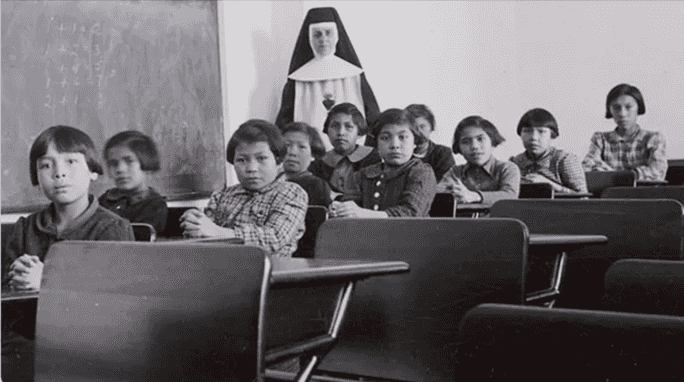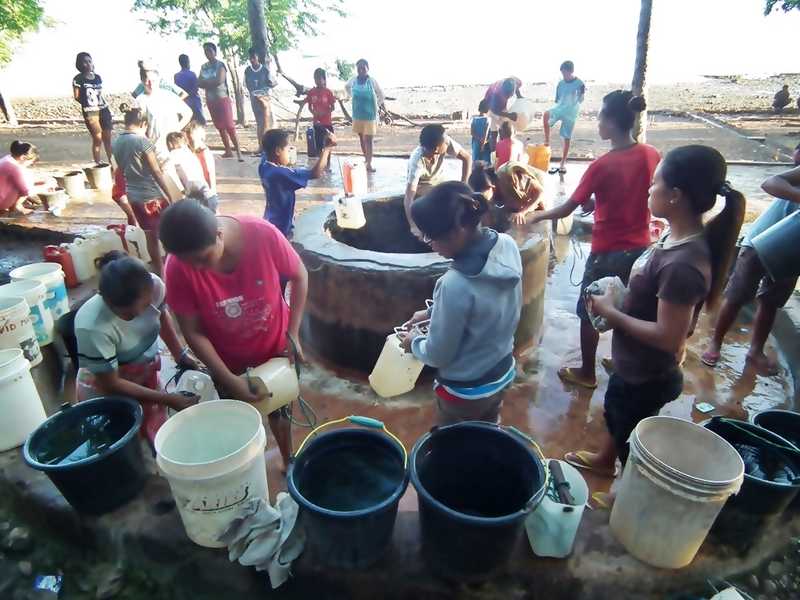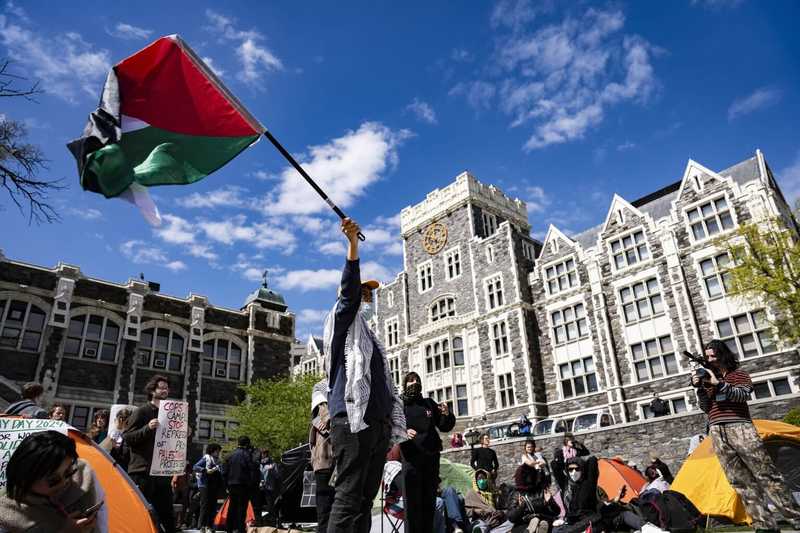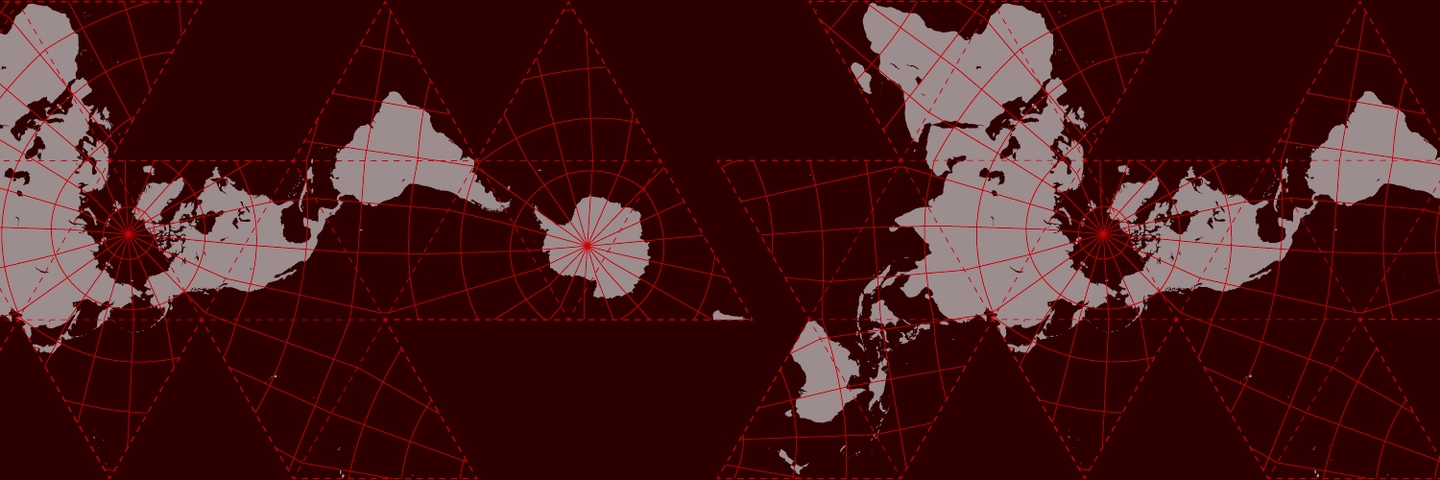
This article is republished from Guyaweb via Wire partner Mediapart
Created in Mana in 1935, this system was approved by the state in 1949, after French Guiana became a department, by publicly funding the placement of children and the development of homes.
The book published in September by the journalist Hélène Ferrarini, Allons enfants de la Guyane, has shed a harsh light on this buried part of Guianan history. A history that is still ongoing, since one last home remains in Saint-Georges-de-l'Oyapock, and is attended by about sixty children from Trois-Sauts, a village without a school.
Residential school of Saint-Laurent-du-Maroni, 1964. © Photo AGFMM
The investigation of our colleague lays the first milestones of a testimonial. Of the 2,000 children who passed through the homes, “about forty former residents have testified in the book, but there is still a lot to reveal,” explains Hélène Ferrarini during a debate organized on December 10 at the Eldorado cinema, Cayenne.
She believes “each home, from Iracoubo, Sinnamary, Maripasoula..., deserves specific research because there are not that many, except for the pioneering work of Françoise Armanville”, published ten years ago.
But “since the release of the book, there is a snowball effect, a need to tell the truth, awareness and courage to speak. Things will change if the former residents decide to tell their stories,” says lawyer Alexis Tiouka, who is involved in the recognition of the indigenous peoples of French Guiana.
A need to speak freely is pressing as direct witnesses are gradually disappearing, like Jean Appolinaire, a Kalin'a who died in June 2021 and whose story is the subject of a chapter in the book.
“Very difficult to talk about what we lived through”
That evening, in the presence of Hélène Ferrarini, former boarders recounted how they were torn away from their families and thrown into Catholic residential schools.
Like Alexis Tiouka, placed in a home at the age of six: “In the homes, we had to bow down to the religious, it was drilled into us. Our hair was shaved like in the military, whereas for us Kalin'a, it is a source of pride and spirituality. Hair is very important in our culture. All these rules were imposed. We were discredited and humiliated all the time. It's very difficult to talk about what we lived through.”
“What hurt me the most was not being able to speak my language anymore,” reacts Eleonore “Kadi” Johannes, who was sent to the Catholic boarding school at age of four. “The homes conditioned the rest of my life. It's no coincidence that I'm still an angry activist today. It's a question of survival,” says the spokesperson for the collective called Or de question.
If these activists of the Amerindian cause speak out, “it is to avoid repeating the same pattern that today bears other names: host family, boarding school”, insists Alexis Tiouka. Perhaps it is due to the nature of the event, but among the audience interventions, one voice stands out. That’s the one of Jean-Paul Fereira, mayor of Awala-Yalimapo and first vice-president of the Territorial Collectivity. Born in the 1970s, he is among the last generation to have attended the Mana home before its closure in the 1980s.
Roucou, like other cultural links, was forbidden to home residents. Only hammocks were allowed. © Photo Boris R-Thébia
Solicited for the book, he had never spoken of his experience before, bringing a precious testimony to the muted decor of the cinema.
“When we entered the residential school, we were given a number. I was number 11. I still remember it today. There was physical and sexual abuse, but many people don't want to talk about it. Even if the home is closed, it is a current event because we live it in our heads, in our veins, in our flesh. I would like to thank Hélène Ferrarini for this book, but I deplore the fact that when it comes to indigenous peoples, it is often the others who speak for us, who do for us.”
“This story is painful, traumatic and taboo,” explains Boris Thebia, a Guainese documentary photographer who has been living in Canada for seven years. There, indigenous populations underwent the same forced assimilation through education, on a large scale (150,000 children placed). A story that resonates with that of the Guianese homes which Boris Thébia wishes to make better known. In Canada, “this is a real social issue” since the government began work on recognition and reparations in 2009.
“The Guianan story could be transposed to the United States, Australia, Scandinavia, wherever indigenous populations have experienced this. In all these countries, Truth and Reconciliation Commissions have been set up to repair this trauma. Not in France,” explains law professor Jean-Pierre Massias, president of the Louis-Joinet Institute, which specializes in transitional justice. “One of the consequences of the book, to overcome the trauma, could be a university research program and a Truth and Reconciliation Commission,” he adds.
In Canada (here in the province of Manitoba, 1940), children were placed in “residential schools.” 150,000 people experienced this forced assimilation system, according to government investigations undertaken between 2009 and 2015. © Photo Library and Archives Canada
“Admit that it happened in France”
In partnership with the Customary Grand Council (GCC) and numerous indigenous organizations (Foag, Onag, JAG, Copag), Jean-Pierre Massias came to Guiana to initiate legal action in recognition of the violence suffered. Comprised of experts (legal professionals, psychiatrists, historians, victims, anthropologists), this commission aimed to “study human rights violations, identify violations, listen to the victims, determine responsibilities, propose measures for reparation and reorganization of society so as to avoid repeating the same facts,” says the legal expert who has worked in Palestine and in Africa. “These are the four principles of the Truth and Reconciliation Commission, which is not there to condemn a government but to obtain reparations in the name of dignity”.
Among the potential reparations, the symbolic ones – “apologizing, erecting monuments, returning stolen objects” – are the most used. “Difficult to quantify and very expensive” financial reparations are rarely used, in Jean-Pierre Massias’ experience.
“We could go as far as the recognition of cultural identity. To guarantee the safekeeping of indigenous language and culture, thereby rebuilding the system by proposing social reforms, especially in education”, hopes the legal expert.
For the moment, Guiana is far from this recognition. The Customary Grand Council organized a seminar in mid-December to discuss the Truth and Reconciliation Commission (TRC) project. But its budget has been frozen by the prefecture, the administrative organization responsible for the representative body.
A budget cut of “15,000 euros”, according to Christophe Yanuwana Pierre, its vice president. And not because of empty coffers. According to Christophe Pierre, there was “85,000 euros of budget left at the GCC in early December, out of a total 195,000 for 2022. Since then, as a sign of increased supervision, the budget (25,000 euros) for the 17-18 December Prosperity gathering has also been suspended.
Denmark, Finland, Canada and the United States have all activated this “instrument for the regeneration of democracy that is the TRC,” says Jean-Pierre Massias, “not France.” A “quite similar” commission did take place during the scandal of the “Reunionese of Creuse”, children in the child welfare system transferred without their consent to French departments facing rural exodus, but “examples remain few”, says the jurist. “The barrier to implementation is not legal or financial, but psychological: to admit that it happened in France.”
To achieve this symbolic and historical recognition of what seems akin to a colonial crime, the Guianese narrative must be “more structured, by inviting, for example, the Church to speak on the subject,” explains the president of the Joinet Institute, who came to distill a method and answer questions: what is the purpose of a TRC, how to set it up, what mission would it have? These questions were discussed and worked on during a seminar on the theme “Aboriginals and school, repairing injustice”, organized on 13 December at the University of Guiana.
During one afternoon, the GCC, meeting in a special assembly, laid the groundwork for the creation of a Truth and Reconciliation Commission. A report on this work is being prepared. It will be the first step towards the opening of a TRC.
“We need therefore to launch a feasibility study, on the ground, for three months. Then one to two years of work to hear witnesses, establish responsibilities and propose remedial measures to be recorded in a report,” explains Jean-Pierre Massias. A project that requires funding to set up a team of experts, an appropriation by the Amerindians and a political will to launch it.
To do this, lobbying of parliamentarians is already underway. Moreover, the seminar coincided with a visit to French Guiana by the president of the National Assembly, Yaël Braun-Pivet, who went to Camopi. She confirmed that she had been informally questioned about the homes and the commission project, and that the President of the Assembly wished to take the subject “head on”.
“It is an ongoing challenge to train and educate young children from these isolated territories without annihilating their culture and history. Beyond education, this issue affects the integration and respect of indigenous populations in French Guiana and throughout France,” she explained.
A rare word from the “authorities”, while neither the State nor the prefecture have said a word since the release of the book and were absent from the seminar to which they were invited. Our request for an interview with the sub-prefect to the inland communes was also refused by the local representative of the state.
“We have to take the law into our own hands,” says Christophe Yanuwana Pierre, spokesperson for Jeunesses autochtones, whose mother and grandmother are former residents of the homes.
This is a way of pushing civil society to act without waiting for the State’s consent, while “it is legitimate to open a Truth and Reconciliation Commission in Guiana because the history of the homes is a time bomb in society. It plays a role in intra-community violence, in suicides, and in cultural destabilization,” says Jean-Pierre Massias. “And the launching of such a commission could open up other traumatic experiences such as slavery, the penal colony... and allow other communities in Guyana to emancipate themselves.”
“Minority populations are often the forward-thinking ones,” said MP Jean-Victor Castor (GDR group), who attended the screening at the Eldorado. “You are organizing yourselves. Maybe the indigenous struggle will lead to a more general emancipation?”
The Amerindian homes would then be the starting point of a larger question: that of the assimilation or domination of the Western world over the indigenous peoples. A Commission would make it possible to put back this event in something more systemic.
Education, the cornerstone
Even if the schools close for good – the last one in operation in Saint-Georges, should be closed with the opening in September 2023 of a school complex in the town, according to the territorial authority of French Guiana (CTG) – “history does not stop and a continuum of difficulties of integration, violence and poverty continues,” analyzes Jean-Pierre Massias, who advocates for deep systemic reform, especially in education.
The schooling of indigenous children and their accommodation are still crucial issues in 2022. According to Libération, about 300 students from isolated communities are currently housed in boarding schools or with host families, mostly on the coast and from the sixth grade onwards, due to the lack of local schools. This is far from ideal and leads to school dropouts.
The CTG has been working for a year on a new policy for host families in order to remedy the numerous dysfunctions of this system.
This is why, beyond the State's recognition of its violence, educational issues could play a central role in the non-repetition measures proposed by the Truth and Reconciliation Commission.
“Education is a human right in itself and enables the realization of other rights,” reminds Alexis Tiouka in the preface to Allons enfants de la Guyane. This stance is similar to French Guiana’s representative of Unicef, the UN agency dedicated to children, who participated in the seminar organized at the university.
According to a 2017 report from the Observatory of Linguistic Practices, about 20 “first schooling” languages are used in French Guiana. Since 1998, the mother-tongue speaker system has made it possible to teach in these regional languages. This is one of the rare efforts to adapt the educational institution to indigenous students.
“Education is intertwined with issues of child protection or host families, because housing in French Guiana, due to its isolation, is a factor of access to education and educational success. This is one of the particularities here, along with the languages”, notes David Chenu.
During the seminar, he led a workshop on the realities of indigenous students: accommodation on the coast, transportation, mobility, family-school link. Between 60 and 70 people attended, compared to 30 for the CVR workshop, a sign of the strong interest in these everyday subjects.
Several observations were made at the end of this workshop and a report will be written in the coming weeks. They are not new and they call first for closer links with the educational institution. “This would be relevant in Trois-Sauts, for example, where there would be a potential of 150 future secondary school students,” emphasizes David Chenu.
Secondly, the need to promote the Amerindian culture on the coast “with ideas such as multiplying the number of Amerindian contact points in the schools where indigenous students are welcomed. This contact point would create a link, to help understand the school mechanisms, speak the same language, avoid blockages and eventually avoid dropping out of school”, says the Unicef delegate.
Only one school on the island of Cayenne has this type of position, according to David Chenu. We were not able to cross-check this information with the school board.
Third observation: the need to increase the participation of children and families in existing systems for a better understanding and support.
“We need to involve them in thinking about what could change, so that the rules are not only set by the institutions. This makes it possible to create more links, to set up emergency mechanisms if there are concerns, for example,” explains David Chenu.
More transparency was also requested during the workshop to allow everyone to understand the realities of children and families, “and to avoid young people finding themselves on the street when boarding schools close on weekends or during the holidays,” emphasizes the Unicef representative.
“There is a lot to be done in French Guiana, but we could draw inspiration to open up from what has been done in Polynesia, for example, where the islands are scattered over the surface of Europe. The answer there is multi-site secondary schools, that's one idea.”
The stakes are high: having local establishments capable of providing suitable education so that the homes are not simply replaced by a differently-named structure producing the same results.


